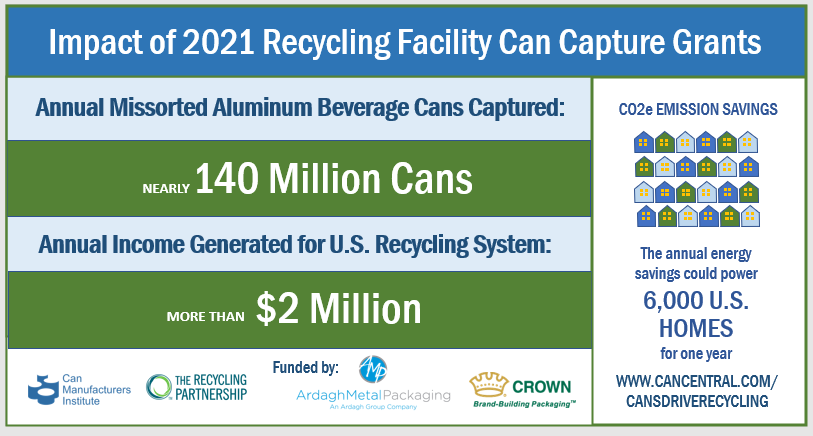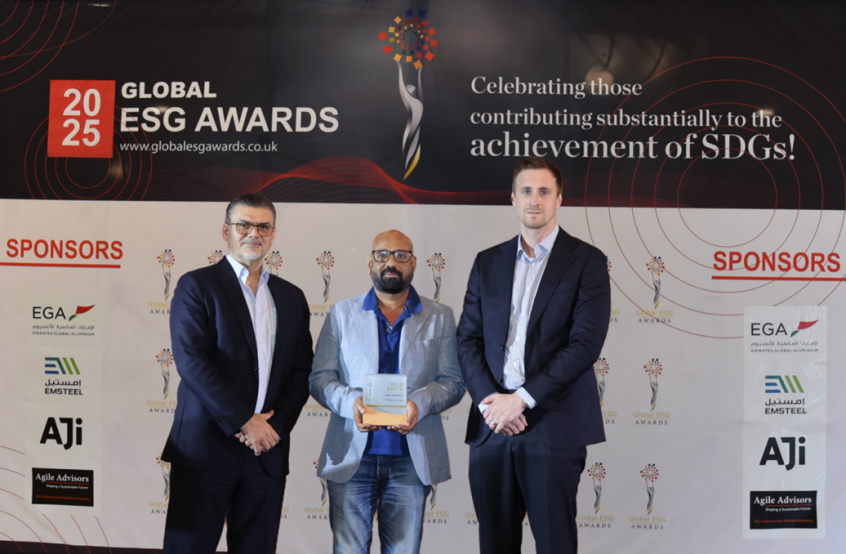Aluminum Beverage Can Manufacturers Ardagh Metal Packaging and Crown Holdings Fund Additional Can Capture Grants at Recycling Sortation Facilities

A chart titled "Impact of 2021 Recycling Facility Can Capture Grants," funded by the Can Manufacturers Institute, The Recycling Partnership, Ardagh Metal Packaging, and Crown. The first stat reads that nearly 140 million missorted aluminum beverage cans are captured annually. The second stat reads that more than two million dollars USD in income is generated for the U.S. Recycling System annually. The third stat reads that the annual C O 2 E emission savings could power 6,000 U.S. homes for one year. At the bottom of the graphic is a link to the Can Central Website: www.cancentral.com/cansdriverecycling.
Washington, DC – May 4, 2023 – Aluminum beverage can manufacturers Ardagh Metal Packaging (Ardagh) and Crown Holdings (Crown) are funding a new grant opportunity as part of their continuing support of activities to spur the installation of additional aluminum can capture equipment in material recovery facilities (MRFs), which sort single-stream recyclables. This new grant opportunity builds on the five grants that Ardagh and Crown funded in 2021.
Facilitated by the Can Manufacturers Institute (CMI), the five grants given in 2021 to MRFs across the country exceeded expectations. The initial estimate was these five grants would fund equipment that when installed would annually capture 71 million aluminum beverage cans, generating a little more than $1 million in revenue for the U.S. recycling system. Recent performance data from four of the five grantees shows the impact is even higher—nearly 140 million aluminum beverage cans captured per year.
“Ardagh and Crown are generously funding recycling system improvements with significant environmental and economic impacts,” reported Scott Breen, CMI’s vice president of sustainability. “CMI’s can recycling impact calculator shows when the nearly 140 million aluminum beverage cans are captured and recycled each year due to the improvements from these grants, the annual impacts are more than $2 million generated for the recycling system and carbon savings realized equivalent to driving a little more than 34 million miles, or nearly 1,400 times around the Earth.”
As with the 2021 grants, the new grants will be offered through The Recycling Partnership, the leading national force for improving recycling. Several grants will be awarded on a rolling basis to MRFs. More information on the grant opportunity can be found at https://recyclingpartnership.org/aluminum-can-capture-grants-for-mrfs/.
“Capturing each aluminum beverage can at MRFs is important since metal recycles forever and used beverage cans (UBC) are consistently one of the most valuable materials in the recycling stream,” said John Rost, Crown’s vice president of global sustainability and regulatory affairs. In fact, CMI-funded research from Gershman, Brickner & Bratton, “Aluminum Beverage Cans: Driver of U.S. Recycling System,” found that without the revenue from UBCs, most MRFs would not be able to operate without changes to their business models. This same research found that up to one in four aluminum beverage cans is missorted at a typical MRF for various reasons including cans being crushed horizontally into flat objects and then sorted like paper.
The extent of the incorrect sorting of aluminum beverage cans varies by MRF. In 2022, Ardagh and Crown contracted Resource Recycling Systems (RRS) to track exactly how many aluminum beverage cans are missorted at five loss points at three diverse MRFs. This on-the-ground analysis found that between seven and 36 aluminum beverage cans are missorted every minute, resulting in an average annual revenue loss of $71,900 per loss point. With the relatively high economic value of UBCs, can capture equipment at these loss points had an average payback of three years.
Beyond the testing and the funding, Ardagh and Crown also financed the development of tools to catalyze additional can capture equipment installation. In 2022, CMI made available a complimentary return-on-investment (ROI) calculator, developed by RRS, that any MRF can use to see the ROI of putting in additional can capture equipment.
“Ardagh is proud to join Crown and continue investing in can sorting efficiencies at MRFs to strengthen aluminum beverage can recycling,” said Jennifer Cumbee, Ardagh’s chief sustainability officer, global metal. “These investments reflect our industry commitment to increase beverage can recycle rates as CMI detailed in our Aluminum Beverage Can Recycling Primer and Roadmap. The objectives and tactics are clear as CMI aluminum beverage can sector members are aligned in improving from a 45-percent aluminum beverage can recycling rate in 2020, which makes it the most recycled beverage container in the United States, to new heights of 70 percent by 2030, 80 percent by 2040 and 90 percent by 2050.”
Recycling more aluminum beverage cans has many benefits. For one, it means more UBC material is available to incorporate into new cans. Today, aluminum beverage cans manufactured in the United States average 73 percent recycled content, the highest average of any beverage container. Additional aluminum beverage can recycling also means a greater environmental and economic impact, as well as more cans exemplifying the circular economy as they go from recycling bin back to store shelf as a new can in as little as 60 days.

A chart titled "Impact of 2021 Recycling Facility Can Capture Grants," funded by the Can Manufacturers Institute, The Recycling Partnership, Ardagh Metal Packaging, and Crown. The first stat reads that nearly 140 million missorted aluminum beverage cans are captured annually. The second stat reads that more than two million dollars USD in income is generated for the U.S. Recycling System annually. The third stat reads that the annual C O 2 E emission savings could power 6,000 U.S. homes for one year. At the bottom of the graphic is a link to the Can Central Website: www.cancentral.com/cansdriverecycling.
###
About Can Manufacturers Institute
The Can Manufacturers Institute (CMI) is the national trade association of the metal can manufacturing industry and its suppliers in the United States. The can industry accounts for the annual domestic production of approximately 130.7 billion food, beverage and general line cans; employs more than 28,000 people with plants in 33 states, Puerto Rico and American Samoa; and generates about $15.7 billion in direct economic activity. CMI members are committed to providing safe, nutritious and refreshing canned food and beverages to consumers in the most sustainable packaging.
2021 Grants Information and Performance Data*
- GEL Recycling in Orange City, FL, installed equipment to detect and capture errant aluminum cans that were missorted into the plastic container stream, resulting in additional capture of a projected 204,000 new pounds per year.
- Independent Texas Recyclers in Houston, TX, installed equipment to capture aluminum that was not detected by the main aluminum sorting equipment, resulting in 2.5 million new pounds of aluminum capture per year.
- Rivers Recycling in Kilgore, TX, installed equipment to move from hand sortation to a modernized and automated process, resulting in a projected 106,000 new pounds of aluminum capture per year.
- Curbside Management in Asheville, NC, catalyzed investment in an eddy current separator, which puts the facility on track to add 1.3 million pounds of recycled aluminum per year.
*Performance data is not yet available for the grant given to the MRF jointly owned by the City of Milwaukee and Waukesha County, but the additional eddy current funded with the grant is expected to capture 27 million aluminum beverage cans per year.
